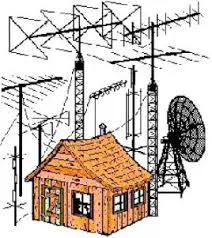
Your home "Ham Shack", the affectionate name for a Ham's room or building that houses all their radio gear, doesn't have to look like this one in order to have lots of fun! Not going to lie, it definitely helps, but is not necessary. In this article I want to briefing touch on the different ways that Hams communicate with each other to give you an idea of how vast and exciting the hobby really can be!
Modes of Communication
All the ways that Hams communicate can be broadly divided into three different categories:
-Phone or Voice
-CW or Morse Code
-Digital
Lets take a look at each one of these categories a little closer.
Phone or Voice
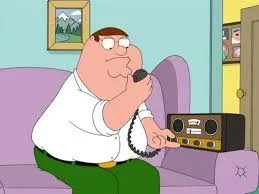
This is the mode that most people think of when they think of ham radio; a person with a hand held mic in front of a glowing, seemingly complicated radio, as Peter Griffin illustrates for us! This is the mode that most people get into first. When you buy your radio after getting your license, all you need to do is attach an antenna for whichever frequency you will be using, plug in a power supply and you are off to the races! Following radio etiquette of course! In this form your voice is converted by the transceiver into radio waves which are then transmitted out from your antenna. Anyone tuned to the proper frequency will be able to hear your transmission. This is an important fact to remember; there is no such thing as a private conversation on the airwaves. Anything that you transmit can be heard by anyone that is listening on the frequency. That is why there are rules for how and what we communicate over the air waves. It is a lot of fun to throw your call sign out on a clear frequency and meet a new friend!
CW or Morse Code
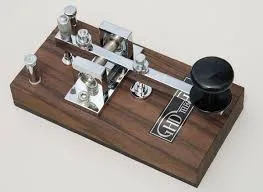
Morse code predates the radio by about 60 years, but is commonly associated with ham radio. Samuel F.B. Morse developed the code around 1837 for efficient communication over the telegraph lines of the day. When developing the code, he started with the most commonly used letter, E and built on it from there so that the most used letters were the easiest to input. Here is the code in its entirety:

The dots on the chart or "dits" stand for short pulses sent by the operator and the dashes or "daws" stand for longer pulses. The great thing about Morse code, or CW as it is called by Hams, is that it takes very little power comparatively to transmit. You can run a 5w CW radio off of a battery for hours and be able to communicate with stations all over the country if not the world depending on which frequency you are on!
Here is a youtube clip of a gentleman using a classic straight key to punch out some Morse code. He is pretty good!
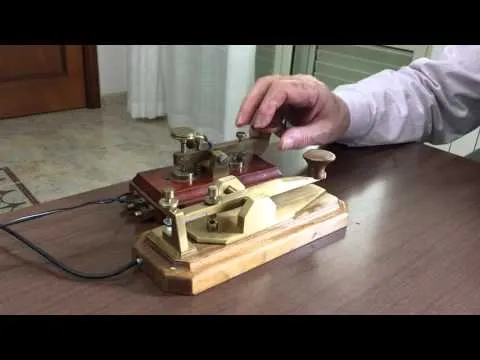
There are other types of keys that can be used for communicating via CW such as Iambic paddles and bugs. You should check those out as well if you are interested!
Digital Modes
All three of these categories could have volumes written about them, but the digital modes are the most vast of the three. To put it simply the digital modes turn the input into audible tones that are transmitted over the airwaves and are then decoded on the other end. The input can be voice, text or pictures are these are converted by a sound card or a terminal node controller (depending on the mode) to tones that are transmitted and picked up by another station with a computer, sound card, radio and antenna that decodes the signal. Here is a quick video showing a mode called FT8 and how a contact is made with the WSJT-X software:
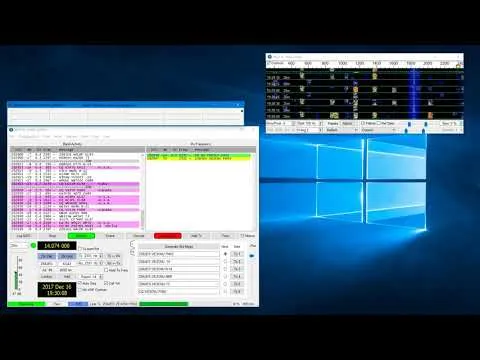
FT8 only has 8 tones that are used to make up the signals. Her is a video of a mode called JT65 that has many more tones to code with:

As you can hear there is a musical sound to these modes that is very cool in my opinion! There are many other modes; this is just the very top of the very tip of the iceberg! There is Radioteletype or RTTY, JT9, Hellschrieber, PSK31, whspr to name a very few! Do a quick google search to see just how vast this part of ham radio can be!
Lets not forget email over radio with a program called Winlink or sending text messages from your radio to any email account or mobile phone using the APRS protocol and even pictures and videos using Slow Scan TV! The possibilities are endless with ham radio. For you Bitcoin fans out there, I even heard of a guy that was able to send Bitcoin from one person to another using a program he wrote and his ham radio!
Don't Stop Now!
This meant to just brush the surface and if I could I would write hundreds of posts on what I have touched on here if I had the time! Please look this stuff up and feel free to ask questions! I am relatively new to this hobby and seem to be learning something new every day and love sharing what I have learned and learning new things with other people. Visit the ARRL website to start your research into this infinitely deep and exciting hobby!
Hope to hear you on the air!
73!
KC1IFK
(73 is an old Morse sub-code meaning "best regards" that we still use to this day as salutations and KC1IFK is my callsign)
Thanks for reading! If you enjoyed the post, please follow me, check out my other posts and leave your comments below. Whether you agree or not, a lot can be learned from a good conservation!
